
- school Campus Bookshelves
- menu_book Bookshelves
- perm_media Learning Objects
- login Login
- how_to_reg Request Instructor Account
- hub Instructor Commons

Margin Size
- Download Page (PDF)
- Download Full Book (PDF)
- Periodic Table
- Physics Constants
- Scientific Calculator
- Reference & Cite
- Tools expand_more
- Readability
selected template will load here
This action is not available.

16.1: Case Study: Respiratory System and Gas Exchange
- Last updated
- Save as PDF
- Page ID 16816

- Suzanne Wakim & Mandeep Grewal
- Butte College
\( \newcommand{\vecs}[1]{\overset { \scriptstyle \rightharpoonup} {\mathbf{#1}} } \)
\( \newcommand{\vecd}[1]{\overset{-\!-\!\rightharpoonup}{\vphantom{a}\smash {#1}}} \)
\( \newcommand{\id}{\mathrm{id}}\) \( \newcommand{\Span}{\mathrm{span}}\)
( \newcommand{\kernel}{\mathrm{null}\,}\) \( \newcommand{\range}{\mathrm{range}\,}\)
\( \newcommand{\RealPart}{\mathrm{Re}}\) \( \newcommand{\ImaginaryPart}{\mathrm{Im}}\)
\( \newcommand{\Argument}{\mathrm{Arg}}\) \( \newcommand{\norm}[1]{\| #1 \|}\)
\( \newcommand{\inner}[2]{\langle #1, #2 \rangle}\)
\( \newcommand{\Span}{\mathrm{span}}\)
\( \newcommand{\id}{\mathrm{id}}\)
\( \newcommand{\kernel}{\mathrm{null}\,}\)
\( \newcommand{\range}{\mathrm{range}\,}\)
\( \newcommand{\RealPart}{\mathrm{Re}}\)
\( \newcommand{\ImaginaryPart}{\mathrm{Im}}\)
\( \newcommand{\Argument}{\mathrm{Arg}}\)
\( \newcommand{\norm}[1]{\| #1 \|}\)
\( \newcommand{\Span}{\mathrm{span}}\) \( \newcommand{\AA}{\unicode[.8,0]{x212B}}\)
\( \newcommand{\vectorA}[1]{\vec{#1}} % arrow\)
\( \newcommand{\vectorAt}[1]{\vec{\text{#1}}} % arrow\)
\( \newcommand{\vectorB}[1]{\overset { \scriptstyle \rightharpoonup} {\mathbf{#1}} } \)
\( \newcommand{\vectorC}[1]{\textbf{#1}} \)
\( \newcommand{\vectorD}[1]{\overrightarrow{#1}} \)
\( \newcommand{\vectorDt}[1]{\overrightarrow{\text{#1}}} \)
\( \newcommand{\vectE}[1]{\overset{-\!-\!\rightharpoonup}{\vphantom{a}\smash{\mathbf {#1}}}} \)
Case Study: Cough That Won't Quit
Three weeks ago, 20-year-old Sacheen came down with symptoms typical of the common cold. She had a runny nose, fatigue, and a mild cough. Her symptoms had been starting to improve, but recently her cough has been getting worse. She coughs up a lot of thick mucus, her throat is sore from frequent coughing, and her chest feels very congested. According to her wife, Sacheen has a “chest cold.” Sacheen is a smoker and wonders if her habit is making her cough worse. She decides that it is time to see a doctor.

Dr. Tsosie examines Sacheen and asks about her symptoms and health history. She checks the level of oxygen in Sacheen’s blood by attaching a device called a pulse oximeter to Sacheen’s finger (Figure \(\PageIndex{2}\)). Dr. Tsosie concludes that Sacheen has bronchitis, an infection that commonly occurs after a person has a cold or flu. Bronchitis is sometimes referred to as a “chest cold,” so Sacheen’s wife was right! Bronchitis causes inflammation and a build-up of mucus in the bronchial tubes in the chest.
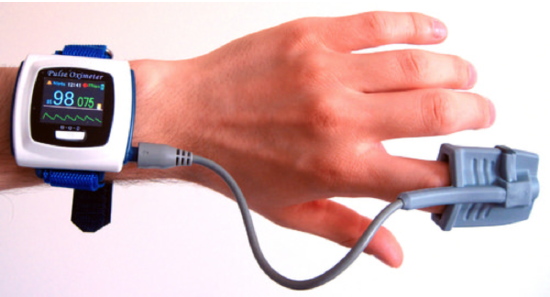
Because viruses, and not bacteria, usually cause bronchitis, Dr. Tsosie tells Sacheen that antibiotics are not likely to help. Instead, she recommends that Sacheen try to thin and remove the mucus by drinking plenty of fluids and using a humidifier, or spending time in a steamy shower. She also recommends that Sacheen get plenty of rest.
Dr. Tsosie also tells Sacheen some things not to do—most importantly, not to smoke while she is sick and to try to quit smoking in the long term. She explains that smoking can make people more susceptible to bronchitis and can hinder recovery. She also advises Sacheen not to take over-the-counter cough suppressant medication.
As you read this chapter on the respiratory system, you will better understand what bronchitis is and why Dr. Tsosie made the treatment recommendations that she did. At the end of the chapter, you will learn more about acute bronchitis, which is the type that Sacheen has. This information may come in handy to you personally because the chances are high that you will get this common infection at some point in your life—there are millions of bronchitis cases every year!
Chapter Overview: Respiratory System
In this chapter, you will learn about the respiratory system, the system that exchanges gases such as oxygen and carbon dioxide between the body and the outside air. Specifically, you will learn about:
- The process of respiration, in which oxygen moves from the outside air into the body and carbon dioxide and other waste gases move from inside the body into the outside air.
- The organs of the respiratory system, including the lungs, bronchial tubes, and the rest of the respiratory tract.
- How the respiratory tract protects itself from pathogens and other potentially harmful substances in the air.
- How the rate of breathing is regulated to maintain homeostasis of blood gases and pH.
- How ventilation, or breathing, allows us to inhale air into the body and exhale air out of the body.
- The conscious and unconscious control of breathing.
- Nasal breathing compared to mouth breathing.
- What happens when a person is drowning.
- How gas exchange occurs between the air and blood in the alveoli of the lungs, and between the blood and cells throughout the body.
- Disorders of the respiratory system, including asthma, pneumonia, chronic obstructive pulmonary disease (COPD), and lung cancer.
- The negative health effects of smoking.
As you read the chapter, think about the following questions:
- Where are the bronchial tubes, and what is their function?
- What is the function of mucus, and why can too much mucus be a bad thing?
- Why did Dr. Tsosie check Sacheen’s blood oxygen level?
- Why do you think Dr. Tsosie warned Sacheen not to take cough suppressant medications?
- How does acute bronchitis compare to chronic bronchitis, and how do they both relate to smoking?
Attributions
- Coughing by GabboT, CC BY-SA 2.0 , via Wikimedia Commons
- Wrist oximeter by UusiAjaja, public domain via Wikimedia Commons
- Text adapted from Human Biology by CK-12 licensed CC BY-NC 3.0

Want to create or adapt books like this? Learn more about how Pressbooks supports open publishing practices.
13.1 Case Study: Respiratory System and Gas Exchange
Created by CK-12 Foundation/Adapted by Christine Miller
Case Study: Cough That Won’t Quit
Three weeks ago, 20-year-old Erica came down with symptoms typical of the common cold. She had a runny nose, fatigue, and a mild cough. Her symptoms were starting to improve, but recently, her cough has been getting worse. She is coughing up a lot of thick mucus, her throat is sore from frequent coughing, and her chest feels very congested. According to her grandmother, Erica has a “chest cold.” Erica is a smoker and wonders if her habit is making her cough worse. She decides that it’s time to see a doctor.
Dr. Choo examines Erica and asks about her symptoms and health history. She checks the level of oxygen in Erica’s blood by attaching a device called a pulse oximeter to Erica’s finger.
Dr. Choo concludes that Erica has bronchitis , which is an infection that commonly occurs after a person has a cold or flu. Bronchitis is sometimes referred to as a “chest cold,” so Erica’s grandmother was right! Bronchitis causes inflammation and a build up of mucus in the bronchial tubes in the chest.
Because bronchitis is usually caused by viruses and not bacteria , Dr. Choo tells Erica that antibiotics are not likely to help. Instead, she recommends that Erica try to thin out and remove the mucus by drinking plenty of fluids and using a humidifier or spending time in a steamy shower. She recommends that Erica get plenty of rest as well.
Dr. Choo also tells Erica some things not to do — most importantly, to stop smoking while she is sick, and to try to quit smoking in the long-term. She explains that smoking can make people more susceptible to bronchitis and can hinder recovery. Finally, she advises Erica to avoid taking over-the-counter cough suppressant medication.
As you read this chapter about the respiratory system, you will be able to better understand what bronchitis is, and why Dr. Choo made the treatment recommendations that she did. At the end of the chapter, you will learn more about acute bronchitis, which is the type that Erica has. This information may come in handy to you personally, because chances are high that you will get this common infection at some point in your life — there are millions of cases of bronchitis every year!
Chapter Overview: Respiratory System
In this chapter, you will learn about the respiratory system — the system that exchanges gases (such as oxygen and carbon dioxide) between the body and the outside air. Specifically, you will learn about:
- The process of respiration, in which oxygen moves from the outside air into the body and carbon dioxide and other waste gases move from inside the body into the outside air.
- The organs of the respiratory system, including the lungs, bronchial tubes, and the rest of the respiratory tract.
- How the respiratory tract protects itself from pathogens and other potentially harmful substances in the air.
- How the rate of breathing is regulated to maintain homeostasis of blood gases and pH.
- How ventilation, or breathing, allows us to inhale air into the body and exhale air out of the body.
- The conscious and unconscious control of breathing.
- Nasal breathing compared to mouth breathing.
- What happens when a person is drowning.
- How gas exchange occurs between the air and blood in the alveoli of the lungs, and between the blood and cells throughout the body.
- Disorders of the respiratory system, including asthma, pneumonia, chronic obstructive pulmonary disease (COPD), and lung cancer.
- The negative health effects of smoking.
As you read the chapter, think about the following questions:
- Where are the bronchial tubes? What is their function?
- What is the function of mucus? Why can too much mucus be a bad thing?
- Why did Dr. Choo check Erica’s blood oxygen level?
- Why do you think Dr. Choo warned Erica to avoid cough suppressant medications?
- How does acute bronchitis compare to chronic bronchitis? How do they both relate to smoking?
Attributions
Figure 13.1.1
Cold/ Look into my eyes forever [photo] by Spencer Backman on Unsplash is used under the Unsplash License (https://unsplash.com/license).
Figure 13.1.2
Wrist-oximeter by UusiAjaja on Wikimedia Commons is used under a CC0 1.0 Universal Public Domain Dedication (https://creativecommons.org/publicdomain/zero/1.0/deed.en) license.
Mayo Clinic Staff. (n.d.). Bronchitis [online article]. Mayoclinic.org. https://www.mayoclinic.org/diseases-conditions/bronchitis/symptoms-causes/syc-20355566
Inflammation of the mucous membrane in the bronchial tubes. It typically causes bronchospasm and coughing
A tiny, nonliving particle that contains nucleic acids but lacks other characteristics of living cells and may cause human disease.
Any member of a large group of unicellular microorganisms which have cell walls but lack organelles and an organized nucleus, including some which can cause disease.
The body system responsible for taking in oxygen and expelling carbon dioxide. The primary organs of the respiratory system are the lungs, which carry out this exchange of gases as we breathe.
Human Biology Copyright © 2020 by Christine Miller is licensed under a Creative Commons Attribution-NonCommercial 4.0 International License , except where otherwise noted.
Share This Book

Respiratory System - Case Study #2 Worksheet with Answers
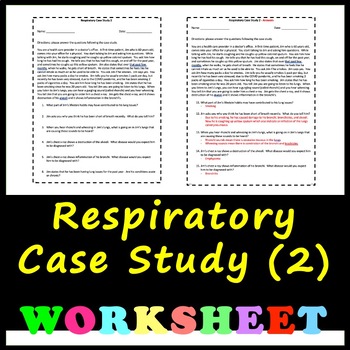
- Word Document File
Also included in
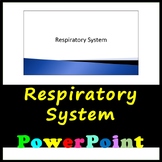
Description
I have created a case study that depicts a person coming into the doctors office for a check up. During the check up, the doctors notices the patient has respiratory issues. This case study goes through basic procedures.
This is a great beginner case study for students to complete.
This case study has questions designed that make students think about the anatomy, physiology, and pathophysiology of the respiratory system. It also has them think about common terms used for the respiratory system.
Downloading my "Respiratory System Anatomy and Physiology PowerPoint" as well has my "Respiratory System Diseases PowerPoint" will help assist your students in completing this case study.
Answers to all the questions are included!
Customer Info:
How to get TPT credit to use on future purchases:
- Please go to your My Purchases page. If you are not logged in, you will not be able to do so. Next to each purchase, you will see a "Provide Feedback" button. Please click it. You will then be taken to a page where you can give a quick rating and leave a short comment for the product. Every time you give feedback, TPT gives you feedback credits that you can then use to lower the cost of your future purchases. I greatly value your feedback as it helps me determine which products are most valuable for you and your students!
Questions & Answers
Mr morans health and nursing sciences.
- We're hiring
- Help & FAQ
- Privacy policy
- Student privacy
- Terms of service
- Tell us what you think
FREE K-12 standards-aligned STEM
curriculum for educators everywhere!
Find more at TeachEngineering.org .
- TeachEngineering
- Creating Model Working Lungs: Just Breathe
Hands-on Activity Creating Model Working Lungs: Just Breathe
Grade Level: 5 (3-5)
Time Required: 45 minutes
Expendable Cost/Group: US $2.00
Group Size: 2
Activity Dependency: Lesson 9
Associated Informal Learning Activity: Creating Model Lungs: Just Breathe!
Subject Areas: Biology
Curriculum in this Unit Units serve as guides to a particular content or subject area. Nested under units are lessons (in purple) and hands-on activities (in blue). Note that not all lessons and activities will exist under a unit, and instead may exist as "standalone" curriculum.
- Walk, Run, Jump!
- Muscles, Muscles Everywhere
- Fascinating Friction!
- Design Devices to Help Astronauts Eat: Lunch in Outer Space!
- Blood Cell Basics
- The Beat Goes On
- Do You Have the Strength?
- 20/20 Vision
- Engineering a Mountain Rescue Litter
- Endocrine Excitement!
- Kidney Filtering
TE Newsletter
Engineering connection, learning objectives, materials list, worksheets and attachments, more curriculum like this, introduction/motivation, vocabulary/definitions, troubleshooting tips, activity extensions, activity scaling, user comments & tips.

By studying the respiratory system, engineers have created technologies such as the heart-lung machine, which keeps patients alive during heart transplants. Engineers are currently working on creating an implantable, artificial lung to aid people with serious lung diseases. One way that engineers study complicated systems is by creating models, similar to how students create their own model lungs in this activity.
After this activity, students should be able to:
- Describe the function of the respiratory system.
- Create a model of the lungs and explain what happens to them when you inhale and exhale.
- Give examples of engineering advancements that have helped with respiratory systems.
Educational Standards Each TeachEngineering lesson or activity is correlated to one or more K-12 science, technology, engineering or math (STEM) educational standards. All 100,000+ K-12 STEM standards covered in TeachEngineering are collected, maintained and packaged by the Achievement Standards Network (ASN) , a project of D2L (www.achievementstandards.org). In the ASN, standards are hierarchically structured: first by source; e.g. , by state; within source by type; e.g. , science or mathematics; within type by subtype, then by grade, etc .
Ngss: next generation science standards - science.
View aligned curriculum
Do you agree with this alignment? Thanks for your feedback!
International Technology and Engineering Educators Association - Technology
State standards, colorado - science.
Each group needs:
- 2-liter empty plastic bottle with cap
- 2 plastic drinking straws; available inexpensively at restaurant supply stores or donated by fast-food chains; do not use the flexible drinking straws
- 2 9-inch balloons
- 1 larger balloon; for example, for a punch ball
- 2 rubber bands
- Lung Worksheet , one per student
Have you ever been on a crowded subway or bus? You probably could not wait to get out where there were not so many people and you could move around freely. This is similar to the process that causes air to flow in and out of your lungs. The air molecules are either crowded outside (in the environment) and want to get into the lungs where there are less air molecules (inhalation), or they want to get outside because they are too crowded inside the lungs (exhalation).
When you inhale, your diaphragm muscle contracts downward and rib muscles pull upward causing air to fill the lungs. Can you think of why? Well, when your diaphragm moves down and ribs move up, they make more space in your chest (in the thoracic cavity) for air. This also decreases the pressure on your lungs so the air will flow in from the outside. The opposite happens when you breathe out. Your diaphragm relaxes and the ribs and lungs push in which causes air to be pushed out.
Engineers need to understand the respiratory process in order to design machines and medicines to help people whose respiratory systems function incorrectly or with difficulty. Have you ever known someone who suffers from asthma or pneumonia? Well, chemical engineers design devices and medicines, such as inhalers filled with an adrenergic bronchodilator to help people breathe better. Engineers have also developed artificial lungs that help people breathe while fighting off infections. And engineers also design the systems that help astronauts breathe easily during space flight, when they are far away from the Earth's atmosphere.
Engineers use models to study complicated processes and better understand them. In this activity, you will act like engineers by building models of the lungs in order to study the breathing process and what happens when you breathe in and out.
Before the Activity
- Gather materials and make copies of the Lung Worksheet .
- In each of the 2-liter bottle caps, drill 2 holes that are just big enough for a drinking straw to fit through. Tip: Make sure to drill the holes far enough apart that the holes do not become one big hole!
- Using a pair of scissors, cut off the bottom of each 2-liter bottle.
With the Students
- Peel off the labels, if any, on the 2-liter bottles.
- Tell students that the 2-liter bottle represents the human chest cavity.
- Stick two drinking straws through the two holes in the bottle cap.
- Place one 9-inch balloon on the end of each straw and secure them with rubber bands, as shown in Figure 2.
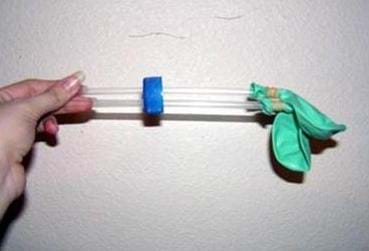
- Tell students that the straws represent the bronchi and the balloons represent the lungs.
- Stick the balloon ends of the straws through the bottle opening and tightly screw on the lid.
- Stretch out the larger balloon and place it over the open bottom of the bottle.
- Tell students that this larger balloon represents the diaphragm. Now they have a finished model of the lungs! (See Figure 3,) Next, it is time to make the lungs work!
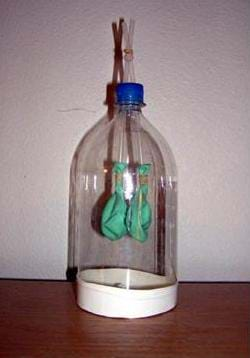
- Pull the diaphragm (balloon) down (that is, away from the lungs) in order to inflate the lungs. (Note: This makes the chest cavity larger and decreases the pressure.)
- Push the diaphragm (balloon) in (towards the lungs) in order to deflate the lungs. (Note: This makes the chest cavity smaller and increases the pressure.)
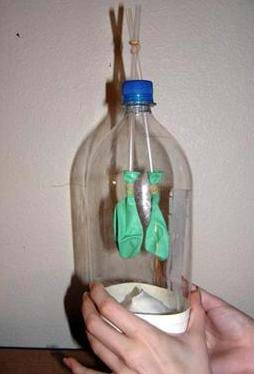
- Have students complete the worksheet.
- To conclude, have teams make presentations of their model lungs, as described in the Assessment section.
bronchi: Two large tubes connected to the trachea that carry air to and from the lungs.
diaphragm: A shelf of muscle extending across the bottom of the rib cage.
lungs: Spongy, saclike respiratory organs that occupy the chest cavity, along with the heart. They provide oxygen to the blood and remove carbon dioxide from it.
Pre-Activity Assessment
Discussion Questions: Solicit, integrate and summarize student responses.
- How do the lungs work? How do you inhale and exhale?
- Does your breathing change when you exercise? How?
Activity Embedded Assessment
Worksheet: Have students record their observations and complete the Lung Worksheet . Review their answers to gauge their mastery of the subject.
Post-Activity Assessment
Presentation and Informal Discussion: Have one or more groups use their projects to demonstrate how the lungs work. Next, hypothesize with the class: What would happen to the respiratory system if we punctured it? Have one group puncture the cavity (bottle) or diaphragm (rubber bottom) and demonstrate what happens to the lungs if this body part is damaged. (Answer: The lungs are unable to inflate and/or deflate if the chest cavity has a leak. The lungs cannot maintain the pressure difference.) Discuss with the class: What could engineers do to help fix a puncture in a person's lungs?
When cutting off the plastic bottle bottom, make sure that the edges are as smooth as possible so it does not rip the balloon on the bottom. If edges are rough, bind them with masking or duct tape.
Seal any potential leaks with poster tack.
Have students research respiratory diseases and how they affect the function of the respiratory system. Can they alter their model to show what happens to the lungs with these diseases? Can they demonstrate on their models what has been done to help people with respiratory problems?
Engineers have developed an artificial lung to help people fight infection. The artificial lung is approximately 18-inches long and consists of membranes that pass oxygen to the blood and remove carbon dioxide. It is inserted through a vein in the leg and lodged in the main vein (the vena cava) passing blood to the heart. The blood is re-oxygenated through a catheter attached to an oxygen supply. Have students create a drawing of a machine that could help their model lungs "breathe" without having them pull down or push up on the lower balloon. Explain that this is how engineers might begin to develop life-saving machines.
For lower grades, have students make one lung rather than two. Use a smaller water bottle rather than a 2-liter bottle and one balloon lung rather than two.

Students learn about the parts of the human respiratory system and the gas exchange process that occurs in the lungs. They also learn about the changes in the respiratory system that occur during spaceflight, such as decreased lung capacity.

Students are introduced to the respiratory system, the lungs and air. They learn about how the lungs and diaphragm work, how air pollution affects lungs and respiratory functions, some widespread respiratory problems, and how engineers help us stay healthy by designing machines and medicines that su...

To gain a better understanding of the roles and functions of components of the human respiratory system and our need for clean air, students construct model lungs that include a diaphragm and chest cavity. Student teams design and build a prototype face mask pollution filter and use their model lung...

Students are introduced to the concepts of air pollution, air quality, and climate change. The three lesson parts (including the associated activities) focus on the prerequisites for understanding air pollution. First, students use M&M® candies to create pie graphs that express their understanding o...

"How is Asthma Treated?" Diseases and Conditions Index, National Heart, Lung and Blood Institute, National Institutes of Health, U.S. Department of Human Services. Accessed May 23, 2006. http://training.seer.cancer.gov/anatomy/respiratory
"Bronchi and Bronchial Tree." Training Website: Bronchi, Epidemiology and End Results (SEER) Program, U.S. National Cancer Institute's Surveillance. Accessed May 23, 2006. http://training.seer.cancer.gov/anatomy/respiratory/passages/bronchi.html
"Respiratory system." Wikipedia, The Free Encyclopedia, Wikipedia,com. Accessed May 23, 2006. https://en.wikipedia.org/wiki/Respiratory_system
Contributors
Supporting program, acknowledgements.
The contents of this digital library curriculum were developed under grants from the Fund for the Improvement of Postsecondary Education (FIPSE), U.S. Department of Education and National Science Foundation (GK-12 grant no. 0338326). However, these contents do not necessarily represent the policies of the DOE or NSF, and you should not assume endorsement by the federal government.
Last modified: May 1, 2020

COMMENTS
Respiratory System Anatomy. Describe the normal anatomy of the respiratory system that would be affected by asthma. Bronchioles, a structure in the respiratory system, are airways that carry air in and out of the lungs. The linings become inflamed, swollen, narrowed, and excess mucus is produced due to asthma. Boyle's Law
The process of respiration, in which oxygen moves from the outside air into the body and carbon dioxide and other waste gases move from inside the body into the outside air. The organs of the respiratory system, including the lungs, bronchial tubes, and the rest of the respiratory tract. How the respiratory tract protects itself from pathogens ...
Respiratory Worksheet Jenna Chmelik Case #1: D. is a 65-year-old male who lives with his wife on their farm. He presents to the clinic with the following vital signs: BP 140/82, HR 91, RR is 28 breaths/minute and shallow, temperature is 101.
CaSE STuDiES WORKSHEET — RESpiRaTORy SySTEm Case Studies Read the following case studies carefully. Complete the sentence with the correct term(s). Baby girl G was delivered at full term to a 25-year-old mother with two other children. There was a prenatal diagnosis of polyhydramnios with left-side diaphragmatic hernia. The infant was
BIOS242 Respiratory case study Worksheet; WEEK 2 QUIZ - week 1 quiz 03/2021; Preview text. Respiratory system infection in elementary school kids (18 points) John,- a ten year old comes home just before thanksgiving break from school feeling tired and complaining of his throat hurting. There have been several cases of respiratory infection ...
I have created a case study that depicts a person coming into the emergency department with trouble breathing.This is a great beginner case study for students to complete.This case study has questions designed that make students think about the anatomy, physiology, and pathophysiology of the respira... Respiratory System - Case Study Worksheet ...
Chapter Overview: Respiratory System. — the system that exchanges gases (such as oxygen and carbon dioxide) between the body and the outside air. Specifically, you will learn about: The process of respiration, in which oxygen moves from the outside air into the body and carbon dioxide and other waste gases move from inside the body into the ...
The respiratory system. The process of physiological respiration includes two major parts: external respiration and internal respiration. External respiration, also known as breathing, involves both bringing air into the lungs (inhalation) and releasing air to the atmosphere (exhalation). During internal respiration, oxygen and carbon dioxide ...
This System Case Study Lesson Package is designed to keep pupils engaged, learning, and collaborating with an authentic real-world case study.With prior knowledge about the respiratory and circulatory system, pupils will analyse given COVID-19 health data (blood oxygen levels, resting heart and breathing rate) to apply and reason with scientific concepts, process skills, science talk moves and ...
Respiratory System Bundle! Your one stop bundle packet resource to keep your students actively learning about the respiratory system.I have created these documents to better assist the learning of my students.This bundle includes PowerPoints, worksheets, handouts, and case studies.PowerPoints has teacher notes in the comments. 10.
Unit 4 Assignment: Respiratory Case Study Executive Summary Respiratory Case Study A patient with a chronic history of asthma develops new symptoms which include headache, body aches, fever and a dry cough. The patient also notes that they feel like they are having a change in their normal typical asthma symptoms and are struggling more than normal to breathe.
This visual worksheet for ''The Respiratory System & Process'' is designed to help you study and reinforce the concepts you've learned in this chapter. ... Case Study - Understanding Respiratory ...
View BIOS242_Respiratory case study Worksheet.docx from BIOS 242 at Chamberlain College of Nursing. BIOS242 12-01-2020 Respiratory system infection in elementary school kids (18 points) John- a ten
Unit 4 Assignment: Respiratory Case Study The respiratory system is responsible for making sure that the cells of the body have adequate oxygen in order to function as well as it is responsible for removing the cellular waste product carbon dioxide. If a disease process is present that affects the functioning of this system, the simple physiological processes will not occur at adequate levels.
By studying the respiratory system, engineers have created technologies such as the heart-lung machine, which keeps patients alive during heart transplants. ... One way that engineers study complicated systems is by creating models, similar to how students create their own model lungs in this activity. Learning Objectives After this activity ...
Case Studies: Respiratory System. 1. Jennifer had been experiencing the symptoms of a sore throat for a couple of days that had become progressively worse. This morning when she woke up, it was extremely difficult and painful to swallow. When she went to the doctor, he could see how red & swollen her tonsils were.
answers to case studies because these are questions, they usually do not have single right answer. discuss the questions with your can stimulate critical. Skip to document. ... Respiratory case study with answers. answers to case studies. Course. Foundations Professional Nursing Practic (NU 211) 44 Documents. Students shared 44 documents in ...
Respiratory Chapters Worksheets. Course: Fundamentals of nursing (0011) 46 Documents. University: North Country Community College. Info. Download. AI Quiz. MNBHgbjhbdd chapter 29 respiratory system function, assessment, and therapeutic measures audio case study listen to the audio case study available on davis edge.
COPD affects the respiratory system in several ways to impair breathing and gas exchange within the lungs.. Airway Inflammation and Narrowing. In COPD, chronic bronchitis causes the airways to ...
Instructions: Roll the die and move that number of spaces, using a coin, paper clip, or other small item to mark your spot. Follow the directions on the game board. If you land on Breathe!, pick a Breath card. A correct answer moves you forward 1 space. If you land on Take a deep breath!, pick a Breath card.
Worksheet. Print Worksheet. 1. Which other body system operates in conjunction with the respiratory system to ensure that oxygen is delivered to all body tissues? Nervous system. Immune system ...
Case Study Worksheet #5: Respiratory System: Name: Paige Fenstermaker Directions: Using your Human Diseases textbook, your Medical Assisting textbook and any other resource, complete the Case Study Worksheet below. 1.
Respiratory System Case Study Worksheet Spring 2023-1-1.docx. School. Idaho State University * *We aren't endorsed by this school. Course. HIT 209. Subject. Biology. Date. Mar 7, 2023. ... Case Study #55 Final CPT Code 31545 RT Laryngoscopy, direct, operative, with operation microscope or telescope, ...
Quiz & Worksheet Goals. These materials contain questions about: Which upper respiratory tract sample collection method would be best in a practice scenario. An advantage of collecting samples ...
Background: This study aimed to systematically review case reports documenting rare adverse events in patients with small cell lung cancer (SCLC) following the administration of immune checkpoint inhibitors (ICIs). Methods: A systematic literature review was conducted to identify case reports detailing previously unreported adverse drug reactions to ICIs in patients with SCLC. The scope of the ...